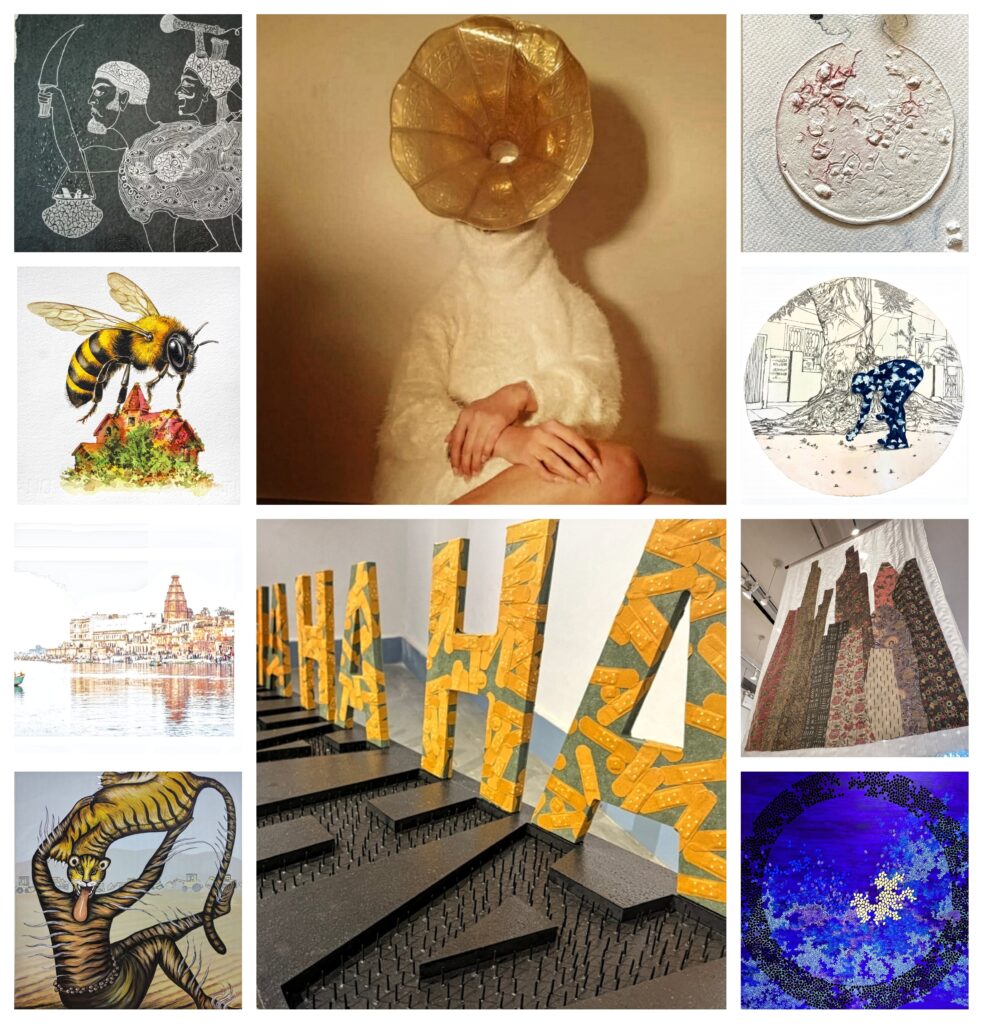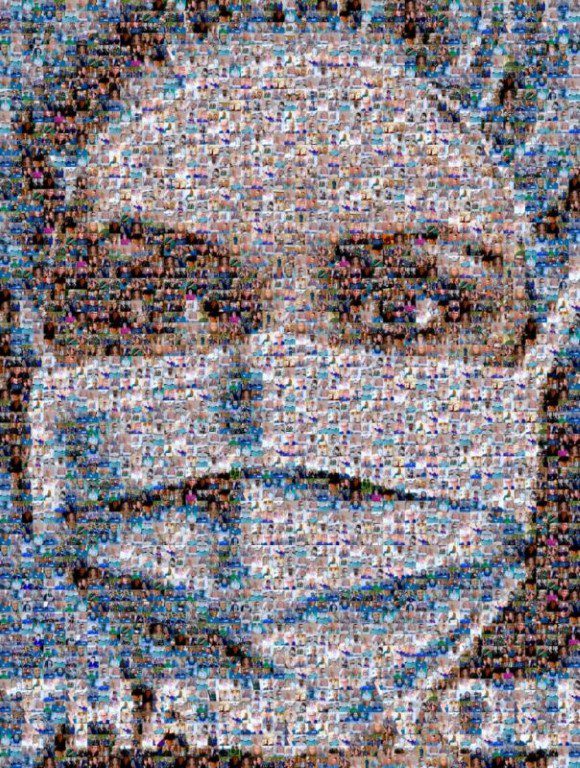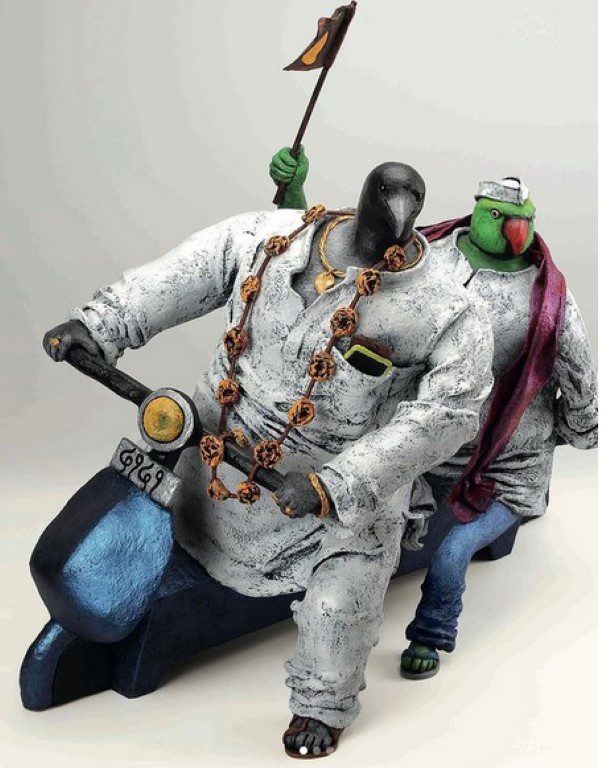“Nahi Rasad rite kaschid arthah pravartate”: no meaningful idea is conveyed if the Rasa is not evoked.”
Bharata Muni in Natyashastra
“Rasa” refers to the emotive zests or essences evoked by a work of art. Bharata Muni, an ancient Indian sage, theorist, and scholar codified nine rasas, each signifying a different emotional state or sentiment. It embodies the feelings of love, beauty, longing; hilarity, mirth and laughter; melancholy, sympathy, and empathy; anger, fury, and violence; valour, bravery, and heroism; fright, dismay, and terror; repulsion, aversion; wonder and amazement; tranquillity, calmness, and accord. The Curator- Manasa has brought together twenty-one artists with myriad concepts and mindsets, bringing forward a framework for understanding and appreciating the emotional depth and complexity of artistic expressions in the exhibition held in March 2024 in Karnataka Chitrakala Parishath, Bangalore. “‘Pollen’ like Emotions are fragile but life-bearing and keep one’s world alive and thriving. As creatures of emotions, we humans are driven by emotions from the time of our birth until death…From personal realms to our surroundings of socio-economic, political, ecological and other conditions that impact us at individual levels and society at large, collectively. Especially in current times of heightened or (over) stimulation, ‘Emotions’ seems to be all over like pollen…..The show title ‘The Pollen Waits on its Tiptoe’ is inspired by the title of a translated book of 26 Kannada poems by the renowned Poet Da Ra Bendre, translated into English by Madhav Ajjampur. So in a way, the title is also an artwork. “The poet pleases our sensibilities, the artist but mirrors the world” (Rasa or the essence is explained as the emotional state of mind, The purity of emotion, to be shared with the ‘Rasika’ or viewer, partaking in the artist’s expression and interpretation and sharing the moment in a particular state of mind.”
Personal storylines, social issues, environmental concerns, and abstract concepts portray one or the other Rasa. There’s a depiction of the darker aspects of urbanization, isolation, alienation, and existential; frustration, outrage, or protest against injustices, political corruption, or environmental degradation; commodification of urban culture; encounter with traditional gender norms and celebration of female sexuality in empowering ways, use of symbolism, allegory, and metaphor to shed light on systemic injustices and provoke critical reflection on the state of society and surroundings. Nudity has been reconnoitred as a subject matter, challenging viewers to confront their attitudes, approaches, biases, and discomforts surrounding the human body. Textile art has deep roots as a vehicle for cultural expression and identity. It occupies a unique space blurring the boundaries between craft and fine art, hanging from the ceiling and making strong statements dangling among the paintings. White appliqué hangings are integrated directly into sculptural compositions, serving as both a decorative and structural element to admire the display through the translucency, enhancing the visual impact and then walking around and seeing the pottery display with flowers. This approach accentuates the immersive and experiential potentials of the artwork. An installation adds another layer of visual complexity, with the lighting casting shadows of the paper sculptures onto the sand and surrounding surfaces, creating mesmerizing patterns and silhouettes.
Amrita Nambiar is the founder and creative director at Olie-an experimental studio that bridges art, design and craft to create distinctive sculptural pieces that play with light and shadow to provoke thought and conversation. Anavi Mullick’s paintings explore questions of belonging and self-identity as they relate to her existence and in relationship to a place. She has empathy/Karuna for each of the figures that she paints. The figures are faceless and are often positioned with their backs turned towards the viewer. In her series of paintings, ‘i see you, i see me,’ she investigates her feelings of isolation, from fearing it, to being comfortable in solitude while also longing for connection. Akshay Mali’s ‘Be yourself’ nude art embodies fearlessness, self-assurance, determination, heroism, valour, and perfect control of body and mind. By choosing to portray the human body in its natural form, the artist defies societal norms and challenges taboos, demonstrating fearlessness in the face of potential criticism or backlash. Initiating such a series by taking a self-portrait reflects the courage to take the first step, embodying the spirit of Veera.
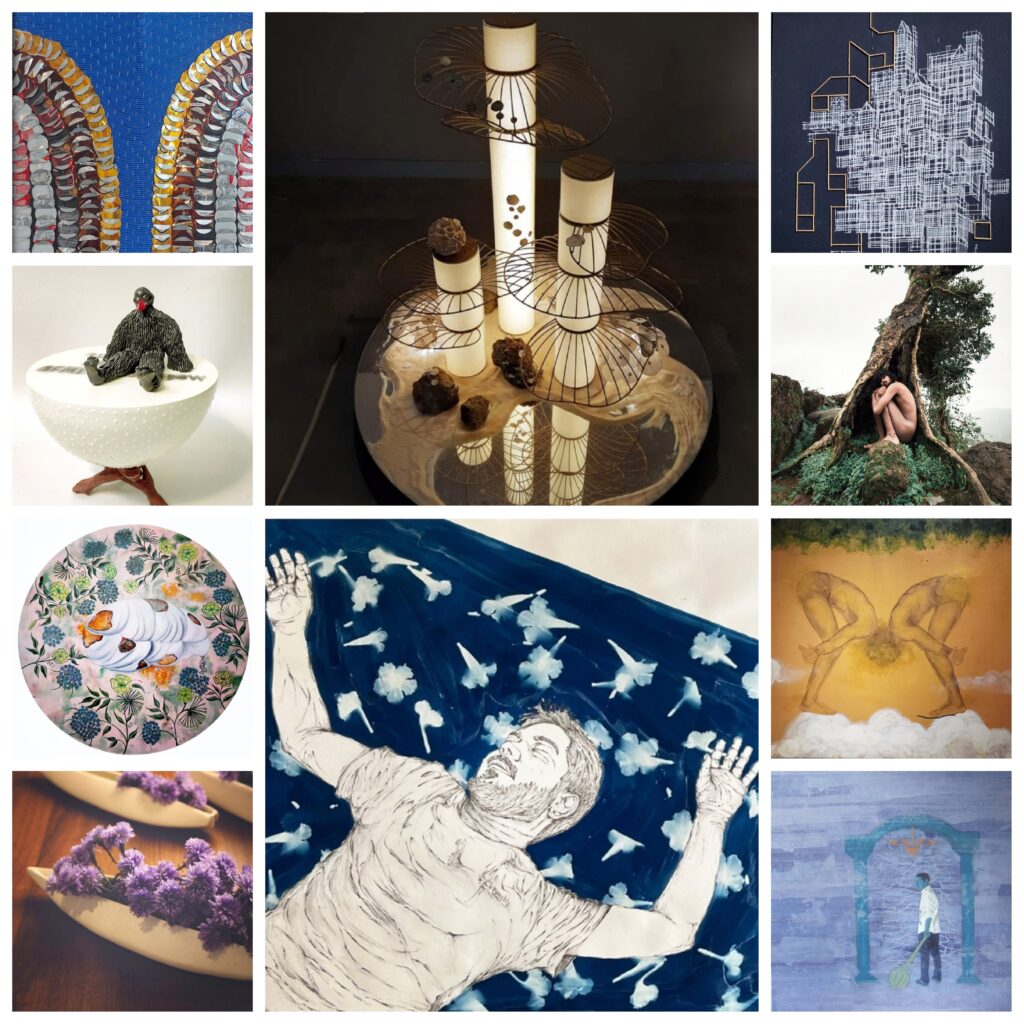
Dimple B Shah’s works are conceptualized with Eco feminist perspectives. The ‘Quixotic Landscape’ is a series of works about unrealistic landscapes with a sarcastic approach. The idea is to bring anthropological-ecological issues to the forefront, where it talks about the existence extinction of humans and all living beings. This set of works aims to evoke Bhaya Rasa – a fear of our existence on this earth. Heena Pari’s quilts (godhadis/ kavandis) reflect her “emotional journey of displacement in the gritty yet captivating landscape of New York City…Utilising the softness of fabric and pattern to confront the stoic masculinity of New York’s buildings became the means to navigate the overwhelming nature of the big city. These Godhadis transcend personal boundaries, offering a means to connect with both the inner self and the broader world.” Preetpal Dahele Preet vases help anyone create beautiful arrangements with leaves and flowers from the garden or local market. Bangalore’s flowering trees, gardens, boulevards, and seedpods are the inspiration for the shapes of these vases. Finally, working with sculptors to get the shapes right and make them into the final products.
Multidisciplinary artist Koyal Raheja’s practice of drawings, paintings and interventions comes from bridging together stories from her memories and public chronicles. Eliciting a sense of wonder/ Adbutha using her childhood memories, she allows for this little autobiographical detail to feed the form itself. Cyanotype and Graphite on paper reflect Mohit Mahato’s struggle through a medical condition and the process of healing, where the images are beautiful, but the process is toxic. While finding solace and peace in the simplicity of Bangalore’s flora, he says, “It’s as if they bloom within me through my artistic practice, reminding me to find Peace (Shantha) in the every day.” Marissa D Miranda’s collection explores the Bhibatsya rasa about our ecology and a dying planet. “Through the use of my raw material, which is primarily urban consumer waste like internet cables and discarded aluminium cans, I attempt to make a positive impact in small and sustainable ways. The fear of the unknown and uncertainty of existence-Sensationalism, fake news, visible scarcity of resources like this current water crisis in Karnataka, add to my feeling of helplessness and anxiety.” Nandesha Shanti Prakash’s ‘A Seductive Chronicle of Deceit’ made of fibreglass and wood enfolds the concept of ‘Putting the biscuit’ in the context of fooling someone as a colloquial expression. “This artwork tries to juxtapose the present scenario of the larger Indian political narrative, where, manipulating public perception, disseminating misinformation on a larger scale, is rampant.”
Pradeep Kumar DM’s work has always reflected the stylized narrative forms and decorative elements related to the visual language of the Lambadi, his native culture. His drawings and paintings primarily explore urban situations through his native aesthetics and imageries. They are reflections of how he has absorbed the development of city spaces; and sometimes inhuman behaviour of society as a whole. Preksha Tater’s works raise dialogues about love, beauty and appearance through the form of visual communication which has a unique ability to transcend cultural and linguistic boundaries, an exploration of what it means to be human.
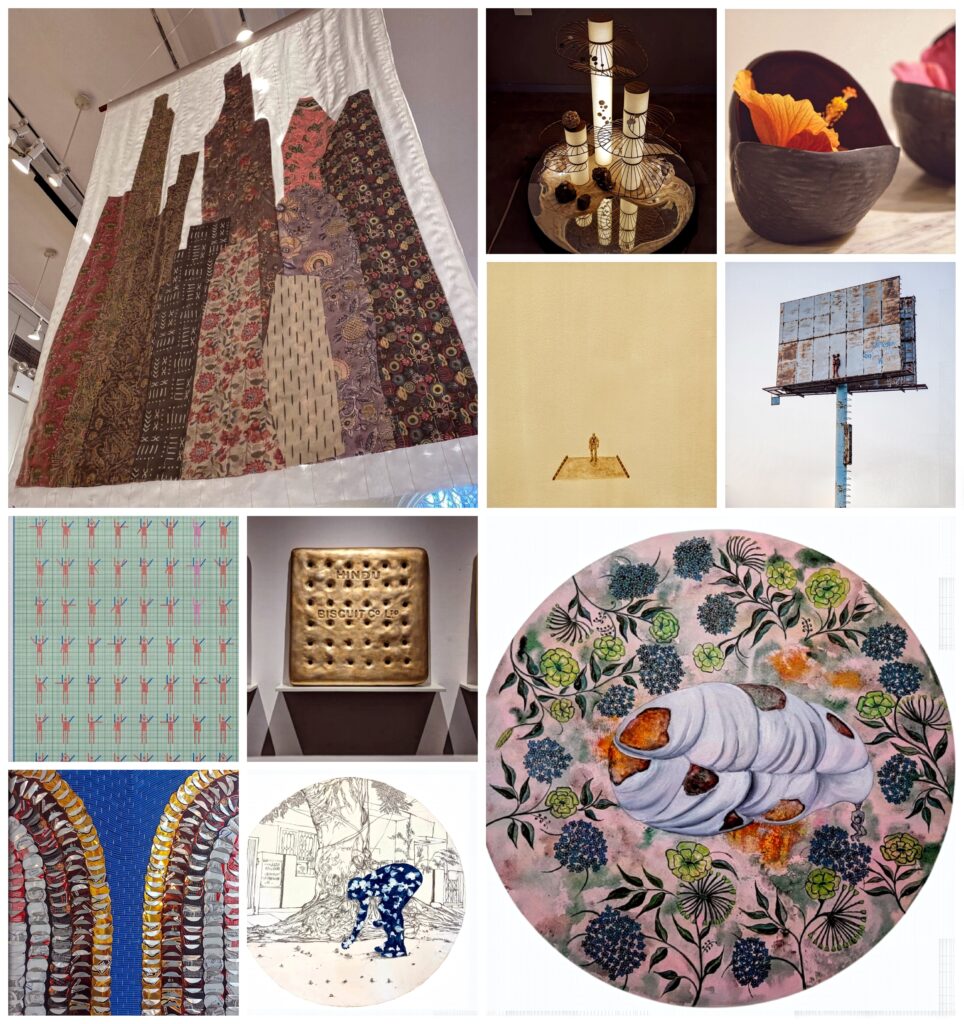
Praveen Kumar finds beauty in the form, line and structures of the buildings, constructing and deconstructing a landscape with his imagination, while incorporating brass elements, inspired from his lineage of goldsmith family. “I seek to reveal how the city attracts, repels, settles, unsettles, and cajoles – all at once. In this particular series, I would want my lines to catch their breaths and reflect in creating beautiful architectural pieces corresponding to Shringara Rasa.” Raghu Kondur visualizes a still human figure in urban surroundings, yet closely aligned with nature. “Urbanization and our desires have taken over territories of nature, which will lead to abhorrence (Bibhatsya) in the future.” Rani Rekha believes that “Contemplating whether what we see is illusion and what we experience is reality, or vice versa, unveils the mysterious layered existence. In this conflict, frustration resulting in anger/ Raudra is a common emotion.” ‘The battle within’ depicts multiple minds and bodies, along with repeated hand gestures, symbolic of the conflict between reality and the imagination. Reemy has used the gramophone as a symbol of the speaker shouting out as loud as one can so that people understand her; the white ribbon is the milk coming out of the breast; and ‘namaste’ to make people understand we are a part of society where nudity comes from our culture, we created Kamasutra, there shouldn’t be any shame in accepting our natural body. Her works revolves around “how we are perceived in a society, how as a human, our body is being sexualized by another human rather than understanding the natural form of it…We live in a country where we see ancient temples full of nude sculptures but we can’t even talk about it as if it’s a sin.”
Shivaprasad KT is weaving a narrative through the cultural context of ‘Pili Pathera’ Tiger’s talk in Tulunadu, the place he comes from. The tiger symbolizes strength, courage, and fearlessness commanding respect and admiration. Unfortunately due to humans’ intervention in the natural landscape and the destruction of ecological imbalance, have been reduced to going extinct. Senthil Kumar M’s photographs aren’t mere snapshots; they are invitations- invitations to breathe deeply, to find solace in the simple moments, hushed stillness and to appreciate the quiet magic that surrounds us, constantly capturing moments through his art that represent life and surroundings. Senthil has developed a unique algorithm and is blurring the lines between art and photographic images. The photographs are reminiscent of watercolour paintings, without any digital manipulation and just through algorithm setting. Sukannya Garg’s work is inspired by her journey of living with an auto-immune condition. “My practice, since, speaks of the silent stories, experiences, wounds and scars that often remain invisible on the skin; and is concerned with the inequality of perception of the body’s internal landscape. My art came to centre around the concept of ‘Every scar has a Story’ to narrate stories and experiences of scarless wounds, alchemizing them through the visual language of cellular biology.” Vishal Kavatekar covers ‘Different faces of Humour- Contradictory Humour, Comedy as commodity, Fun Time and Laugh out loud- portraying “the dual nature of humour; refers to the idea of treating comedy as a product or service that can be bought, sold, and consumed within the marketplace; positivity that radiates and uplifts all those around; wholeheartedly embrace the laughter.” Venugopal VG’s images come together from various sources- either from the real or fictitious world- and the conscious efforts to be in the change of scale also generate a sense of curiosity and surprise in the visual language corresponding to ‘Adbutha’ nature. “I look at my environs from a perspective of constant change and try to introspect on the physical and emotional impact it brings into my personal space. The images are caught between complex situations and dilemmas of reality.”
The show invites the viewers to immerse themselves in the emotional experiences conveyed by the art pieces and indulge in the nuances of each rasa. Through their use of materials, techniques, imagery, symbolism, and narrative structure, the artists convey emotions, stories, and ideas, alluring viewers to engage with the artwork on both a visual and tactile level. Overall, the exhibition offers rich and multifaceted mediums for creative countenance- technical skill, conceptual depth, and aesthetic innovation, coalescing craftsmanship, storytelling, and innovation in ways that engage both the senses and the intellect.
Image Courtesy – Dr Alka Chadha Harpalani

